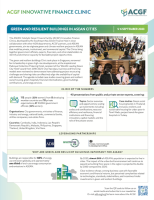Rising energy costs and cooling demands underscore the urgency of a transition to green solutions.
The emergence of generative artificial intelligence (GenAI), machine learning, 5G, and the Internet of Things (IoT) stands to fundamentally change how we work, interact, and live. These technologies enable global connectivity, dramatically enhance our collective productivity, and drive breakthroughs in critical areas, such as health care, education, and climate resilience. Data centers are at the heart of these megatrends, with global data storage capacity demand expected to surge from 10.1 trillion gigabytes in 2023 to a staggering 21 trillion gigabytes by 2027.
Consequently, data centers are rapidly growing in their share of energy use. The International Energy Agency reports that data centers account for 1% to 1.5% of global electricity consumption. Alarmingly, some governments and corporations are considering reverting to fossil fuels to power this demand. Achieving net zero goals, however, requires cutting carbon emissions from these facilities by half by 2030. Additionally, a mid-size data center can use over 1 million liters (300,000 gallons) of water daily. The challenge is clear: how can the industry balance growth with sustainability, ensuring energy and water efficiency while meeting the rising need for data processing?
Southeast Asia is at the forefront of this digital transformation, and ASEAN countries are competing to build data center capacity. Currently, Singapore hosts over 1 gigawatt (GW) in data center capacity across more than 100 facilities, with another 480 MW spread across Indonesia, Malaysia, the Philippines, Thailand, and Viet Nam. These investments fuel digital transformation and drive sustainable, inclusive economic growth by enhancing quality, improving access, and lowering costs in sectors like healthcare, education, and financial services—but they also raise urgent sustainability questions: How can we align this growth with climate commitments? What technologies can enhance energy efficiency, and how do we finance them? How will we source the renewable energy required, and what role must policymakers and grid planners play? What broader policy considerations—like energy efficiency standards, data localization, and water usage—must governments address?
The ACGF Innovative Finance Clinic for Green Data Centers
To explore these questions in the Southeast Asian context, the ASEAN Catalytic Green Finance Facility (ACGF), which is managed by the Asian Development Bank (ADB), in collaboration with Infrastructure Asia and with support from the Government of the United Kingdom, organized the ACGF Innovative Finance Clinic for Green Data Centers in Southeast Asia in October 2024. Held in Singapore, this event brought together almost 100 participants, including policymakers from 18 ministries across seven Southeast Asian governments, and over 30 private sector organizations, including data center developers, operators, technology providers, financiers, and advisors to identify private and public sector solutions and policy frameworks for sustainable data center development. Discussions included strategies for improving energy and water efficiency, integrating renewable energy into data centers, developing regulatory standards, structuring and financing of greenfield data center projects, and financing green infrastructure.
Bringing the public and private sectors together was one of the key objectives of the event. "One of the key strengths of the Asian Development Bank is we do both sovereign lending with governments, and we're increasingly focused on our private sector [development] shift," stated Jackie Surtani, Regional Director of ADB’s Singapore Office.
The event emphasized five key themes.
- Technological Advances in Energy and Water Efficiency. The industry is seeing rapid technology developments focused on efficiently using power and water. Operators are increasingly sourcing renewable energy, either directly or through the grid, while also exploring ways to improve cooling efficiency. Experts discussed emerging solutions, such as liquid cooling, immersive cooling, AI-driven energy management, and waste heat recovery. These innovations can significantly reduce the energy footprint of data centers.
- Financing Challenges and Solutions. Technologies that reduce power usage effectiveness (PUE) and water usage effectiveness (WUE) are increasingly available, but it remains crucial to lower deployment costs and de-risk projects - particularly in emerging markets. Participants discussed blended and concessional finance and sustainability-linked loans as enablers for scaling green technologies. Additionally, portfolio financing was highlighted as a way to provide expansion capital for data center developers seeking to enter new markets.
- Government Support and Policy Initiatives. Governments across Southeast Asia are adopting measures to encourage the development of energy-efficient and sustainable data centers. These initiatives include grants, tax breaks, and partnerships, particularly in sectors aligned with national green growth strategies and digital transformation agendas. The drive for sustainability is often tied to broader goals, such as increasing the share of renewable energy in the power mix and improving overall energy efficiency. Governments are also looking at public–private partnerships (PPP) as a modality to maximize whole-of-life value for money on government data centers.
- Aligning Digital and Energy Policies. Coordination between digital policy and energy sector policy should go hand in hand. As data center operators demand renewable energy, investments in renewable energy and grid enhancements to carry clean electrons must be considered. A mapping of demand centers (data centers) and supply centers (sources of clean power) is necessary, as is policy around the extent to which data centers can utilize captive renewable power rather than draw from the grid.
- The Role of Green Certifications. Adoption of internationally recognized certification standards can also lead to adoption of newer technologies. Tan Shi Hao of sustainability consultancy Building System & Diagnostics Pte Ltd presented the increasing importance of green certifications for data centers. Certifications such as Green Mark for Data Centres, LEED, Uptime Institute's Tier Certification, ISO 50001, and ASHRAE Standard are becoming essential benchmarks for sustainable operations. These certifications offer multiple benefits for data center operators, including improved energy efficiency, significant cost savings, enhanced reliability and performance, and reduced environmental impact.
To illustrate some of these state-of-the-art developments, the workshop showcased Singapore’s Green Data Center Roadmap, highlighting its leadership in sustainable data center practices. This strategy includes enhancing power and water efficiency measures, actively promoting green certifications, and collaborating with industry stakeholders to develop energy efficiency standards. Participants also toured the Sustainable Tropical Data Centre Testbed (STDCT) at the National University of Singapore (NUS), a collaborative facility where industry partners and researchers co-develop and pilot innovative cooling technologies tailored to tropical climates.
Financing Green Data Centers and the Role of Development Banks
The event also underscored the role development banks can play in driving impact, not only as financiers but also as conveners of public and private sector actors.
At the project level, development banks can provide support by offering concessional and blended finance for innovative green technologies aimed at driving power usage effectiveness. This involves financing projects that incorporate advanced technologies to reduce energy consumption and improve overall efficiency and making an otherwise unbankable project bankable. Development banks can also offer solutions to reduce risks associated with new builds in developing countries and support government agencies to structure and tender their public data center projects as public–private partnerships.
At the sector level, development banks can engage in building renewable energy sources and strengthening electricity grids to support the digital economy. This includes investing in infrastructure that enables the integration of renewable energy into the power supply for data centers, thereby reducing their carbon footprint.
At the regional level, development banks can foster cooperation by working with bodies, such as ASEAN, to harmonize regulations and integrate sustainable practices into the digital transformation agenda. This involves collaborating with regional organizations to create a unified approach to sustainability, ensuring that best practices are adopted across the board.
Boosting Regional Efforts
The ASEAN Centre for Energy (ACE), an intergovernmental organization within ASEAN, advocates for a coordinated approach among member states that not only promotes energy-efficient data centers but also ensures their effective integration into the region’s digital transformation. Its white paper on building reliable, simplified, sustainable, and smart next-generation data centers in the region recommends harmonized regional standards and regulations, research and development investments, knowledge sharing, and the establishment of public–private financing frameworks.
Cohesive regional energy and digital sector pathways can significantly support Southeast Asia in managing the opportunities and challenges of its data center boom. By embracing sustainable practices and policies, the region can establish itself as a global leader in green digital infrastructure, driving both economic growth and environmental stewardship.


